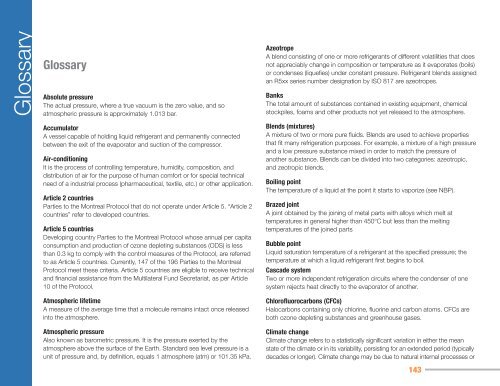Manual for Refrigeration Servicing Technicians - UNEP - Division of ...
Manual for Refrigeration Servicing Technicians - UNEP - Division of ...
Manual for Refrigeration Servicing Technicians - UNEP - Division of ...
You also want an ePaper? Increase the reach of your titles
YUMPU automatically turns print PDFs into web optimized ePapers that Google loves.
Glossary<br />
Glossary<br />
Absolute pressure<br />
The actual pressure, where a true vacuum is the zero value, and so<br />
atmospheric pressure is approximately 1.013 bar.<br />
Accumulator<br />
A vessel capable <strong>of</strong> holding liquid refrigerant and permanently connected<br />
between the exit <strong>of</strong> the evaporator and suction <strong>of</strong> the compressor.<br />
Air-conditioning<br />
It is the process <strong>of</strong> controlling temperature, humidity, composition, and<br />
distribution <strong>of</strong> air <strong>for</strong> the purpose <strong>of</strong> human com<strong>for</strong>t or <strong>for</strong> special technical<br />
need <strong>of</strong> a industrial process (pharmaceutical, textile, etc.) or other application.<br />
Article 2 countries<br />
Parties to the Montreal Protocol that do not operate under Article 5. “Article 2<br />
countries” refer to developed countries.<br />
Article 5 countries<br />
Developing country Parties to the Montreal Protocol whose annual per capita<br />
consumption and production <strong>of</strong> ozone depleting substances (ODS) is less<br />
than 0.3 kg to comply with the control measures <strong>of</strong> the Protocol, are referred<br />
to as Article 5 countries. Currently, 147 <strong>of</strong> the 196 Parties to the Montreal<br />
Protocol meet these criteria. Article 5 countries are eligible to receive technical<br />
and financial assistance from the Multilateral Fund Secretariat, as per Article<br />
10 <strong>of</strong> the Protocol.<br />
Atmospheric lifetime<br />
A measure <strong>of</strong> the average time that a molecule remains intact once released<br />
into the atmosphere.<br />
Atmospheric pressure<br />
Also known as barometric pressure. It is the pressure exerted by the<br />
atmosphere above the surface <strong>of</strong> the Earth. Standard sea level pressure is a<br />
unit <strong>of</strong> pressure and, by definition, equals 1 atmosphere (atm) or 101.35 kPa.<br />
Azeotrope<br />
A blend consisting <strong>of</strong> one or more refrigerants <strong>of</strong> different volatilities that does<br />
not appreciably change in composition or temperature as it evaporates (boils)<br />
or condenses (liquefies) under constant pressure. Refrigerant blends assigned<br />
an R5xx series number designation by ISO 817 are azeotropes.<br />
Banks<br />
The total amount <strong>of</strong> substances contained in existing equipment, chemical<br />
stockpiles, foams and other products not yet released to the atmosphere.<br />
Blends (mixtures)<br />
A mixture <strong>of</strong> two or more pure fluids. Blends are used to achieve properties<br />
that fit many refrigeration purposes. For example, a mixture <strong>of</strong> a high pressure<br />
and a low pressure substance mixed in order to match the pressure <strong>of</strong><br />
another substance. Blends can be divided into two categories: azeotropic,<br />
and zeotropic blends.<br />
Boiling point<br />
The temperature <strong>of</strong> a liquid at the point it starts to vaporize (see NBP).<br />
Brazed joint<br />
A joint obtained by the joining <strong>of</strong> metal parts with alloys which melt at<br />
temperatures in general higher than 450°C but less than the melting<br />
temperatures <strong>of</strong> the joined parts<br />
Bubble point<br />
Liquid saturation temperature <strong>of</strong> a refrigerant at the specified pressure; the<br />
temperature at which a liquid refrigerant first begins to boil.<br />
Cascade system<br />
Two or more independent refrigeration circuits where the condenser <strong>of</strong> one<br />
system rejects heat directly to the evaporator <strong>of</strong> another.<br />
Chlor<strong>of</strong>luorocarbons (CFCs)<br />
Halocarbons containing only chlorine, fluorine and carbon atoms. CFCs are<br />
both ozone depleting substances and greenhouse gases.<br />
Climate change<br />
Climate change refers to a statistically significant variation in either the mean<br />
state <strong>of</strong> the climate or in its variability, persisting <strong>for</strong> an extended period (typically<br />
decades or longer). Climate change may be due to natural internal processes or<br />
143

















